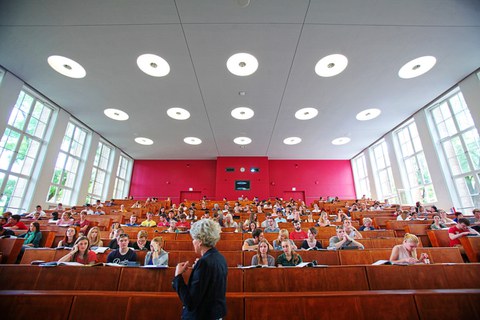TU Dresden at a glance
A world-class university
TUD is one of the largest universities of technology in Germany and enjoys a prominent role among Germany’s universities with the wide range of subjects it offers. With 17 Faculties across five Schools, it offers 119 degree programs and undertakes leading research in its five Research Priority Areas: (1) Health Sciences, Biomedicine and Bioengineering, (2) Information Technology and Microelectronics, (3) Materials Science and Engineering, (4) Energy, Mobility and Environment, and (5) Culture and Societal Change. TUD is a member of TU9, an alliance of the nine leading Universities of Technology in Germany. As a partner of the DRESDEN-concept Science and Innovation Campus, TUD is also a member of a one-of-a-kind network of research and cultural institutions.
Studying at TU Dresden
Research at TU Dresden
Excellent
Since 2012, TUD has been one of the German Universities of Excellence. The Excellence title confirms the potential of one of Germany’s largest technical universities and is a driving force for its research and innovation. In 2019, TUD successfully defended its University of Excellence title with its Excellence Proposal, TUD 2028 – Synergy and beyond. At the moment, three Clusters of Excellence are based at TUD. These are:
PoL: Physics of Life
ct.qmat: Complexity and Topology in Quantum Matter
CeTI: Centre for Tactile Internet
The former Clusters of Excellence Center for Advancing Electronics Dresden (cfaed) and Center for Regenerative Therapies Dresden (CRTD) continue to exist as research clusters, as does the Graduate School Dresden International Graduate School for Biomedicine and Bioengineering (DIGS-BB).
Excellence: Guiding Principle of University Development
Dynamic
About 29,000 students are enrolled at TUD – three times as many as in 1990. Internationally, TUD has earned an outstanding reputation. Currently, every fifth student comes from abroad. Today, about 8,300 employees from 89 countries work at TUD Dresden University of Technology. Its third-party funding has increased from EUR 102.7 million (2005) to EUR 357.4 million (2022). TUD boasts the most patent applications of all German universities (2010-2019) and is among the top 100 universities in the Times Higher Education Impact Rankings for Industry, Innovation and Infrastructure (2022). TUD | excite was founded to reinforce our innovation and entrepreneurial spirit, to integrate professional services and research into technology transfer into our university, and to provide an innovation hub for TUD members as well as investors and industry partners.
Connecting
TUD covers many bases to create knowledge for life: from the fundamentals of the natural sciences to robotics and artificial intelligence to the science of humankind and our cultures such as health, aging, ethics, mobility, construction, nature conservation, and innovative forms of harnessing energy. Traditional disciplinary boundaries are blurred in the process. Our vision is to continue TU Dresden’s transformation into a globally oriented yet regionally anchored top university for the 21st century. TUD’s vibrant scientific community actively assumes societal responsibility – from supporting structural change in the Lusatia coal region to standing up for democracy.
TUD stands for values such as tolerance and openness to the world and expresses this regularly, publicly and visibly.
Family friendly and environmentally friendly
Our university supports students and staff in balancing family, studies and work. Since 2007, TUD has been a certified family-friendly university. With its Equal Opportunities Concept, TUD addresses the gender equality policy as a core task with commitment and determination. In January 2003, TU Dresden became the first technical university in Germany to have a validated environmental management system according to the EMAS regulation.
Family-friendly university
Occupational Safety, Health and the Environment
Promoting health
Motivated and productive employees and students are crucial factors for TU Dresden's success. With the motto “Together: Fit - Healthy - Productive,” TU Dresden has established a university health management system with the aim of promoting and maintaining the health of employees and students for the long term.


